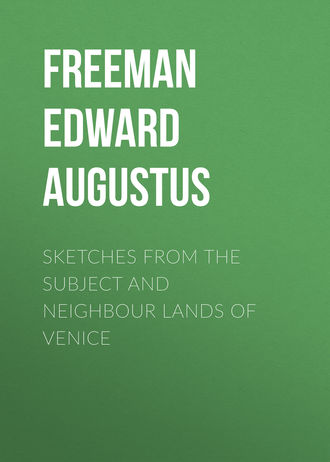
Freeman Edward Augustus
Sketches from the Subject and Neighbour Lands of Venice
The fittings of the church are largely of Renaissance date, but the patriarchal throne remains, and there are one or two fragments of columns and the like put to new uses. On the north side of the nave is a singular building, known as the sacrario, of which it is not easy to guess the original purpose. It is a round building supporting a miniature colonnade with a conical roof above, so that it looks more like a model of a baptistery than anything else. Those who see Cividale before Aquileia may be reminded of the baptistery within the Templum Maximum. But the Forojulian work is larger than the Aquileian, and we can hardly fancy that this last was really designed to be used for baptism; at all events there is a notable baptistery elsewhere.
In the basilica of Aquileia we have three marked dates, but we may call it on the whole a church of the eleventh century, keeping portions of a church of the fourth, and itself largely recast in the fourteenth. Thus, setting aside later changes, the existing church shows portions of work a thousand years apart, and spans nearly the whole of Aquileian history. When the rich capitals of the transepts were carved, the days of persecution were still of recent memory; when pointed arches were set on the ancient columns, the temporal power of the patriarchate was within a century of its fall. The first church of Aquileia is assigned to the bishop Fortunatian, who succeeded in 347, the last prelate who held Aquileia as a simple bishopric without metropolitan rank. The builder and consecrator of the present church – for present we may call it, though it shows less detail of his work than of either earlier or later times – was Poppo or Wolfgang, patriarch from 1019 to 1042, a man famous in local history as the chief founder of the temporal power of the patriarchate. His influence was great with the Emperors Henry the Second and Conrad the Second; he accompanied the latter prince to his Roman coronation, and must therefore have stood face to face with our own Cnut. The name of this magnificent prelate suggests his namesake, who at the very same moment filled the metropolitan throne of Trier, and was engaged in the same work of transforming a great church of an older day. If we compare Trier and Aquileia, we see how men's minds are worked on by local circumstances and local associations. Poppo of Aquileia and Poppo of Trier were alike German prelates, but one was working in Germany and the other in Italy. The northern Poppo therefore gave the remodelled church of Trier a German character, while the remodelled church of Aquileia remained, under the hands of the southern Poppo, a church thoroughly Italian. We may even say that the essential character of the building was not changed, even by the still later remodelling which brought in the pointed arches; these were the work of Markquard of Randeck, who was translated from Augsburg to the patriarchal see in 1365, and who held it till 1381. He brought in the received constructive form of his day, but he did not by bringing in pointed arches turn the building into Italian Gothic. The church of Markquard remained within and without a true basilica, keeping the general effect of the church of Poppo, perhaps even of the church of Fortunatian. The walls of the church moreover show inscriptions of much later date, recording work done in the church of Aquileia in the days of Apostolic sovereigns of our own time. The newest of all, which was not there in 1875, but which was there in 1881, bears the name of the prince who has ceased to be lord of Forum Julii, but who still remains lord of Aquileia.
But the basilica itself is not all. A succession of buildings join on to the west: first a loggia, then a plain vaulted building, called, but without much likelihood, an older church, which leads to the ruined baptistery. The old map shows this last with a high roof or cupola, and then the range from the western baptistery to the great eastern apse must have been striking indeed. Fragments of every kind, columns, capitals, bits of entablature, lie around; and to the south of the church stand up two great pillars, the object of which it is for some local antiquary to explain. The old map shows that they stood just within the court of the patriarchal palace, which was then a ruin, and which has now utterly vanished. They are not of classical work; they are not columns in the strict sense; they are simply built up of stones, like the pillars of Gloucester or Tewkesbury. Standing side by side, they remind us of the columns which in towns which were subject to Venice commonly bear the badges of the dominion of Saint Mark. But can we look for such badges at Aquileia? The lands of the patriarchate, in by far the greater part of their extent, did indeed pass from the patriarch to the Evangelist. But had the Evangelist ever such a settled possession of the city itself as to make it likely that columns should be set up at Aquileia as well as at Udine? The treaty which confirmed Venice in the possession of the patriarchal state left the patriarchal city to its own bishop and prince. Was the winged lion ever set up, and then taken down again? The old map which represents Aquileia in the fifteenth century shows that, as the pillars carry nothing now, so they carried nothing then. Again, would Venetian taste have allowed such clumsy substitutes for columns as these? And, if they had been meant as badges of dominion, would they not have stood in the forum rather than in the court of the Patriarch's palace?
We are far from having exhausted even the existing antiquities of Aquileia, further still from exhausted its long and varied history. Within the bounds of the fallen city pleasant walks may be taken, which here and there bring us among memories of the past. Here is a fine street pavement brought to light, here a fragment of a theatre. But men do not dig at Aquileia with the same vigour with which they dig at Silchester and at Solunto. The difference between the diggings at the beginning and the end of a term of six years is less than it should be. But we have perhaps done enough to point out the claims of so wonderful a spot on those who look on travelling as something more than a way either of killing time or of conforming to fashion. Aquileia has a character of its own; it is not a ruined or buried city; nor is it altogether like Trier or Ravenna, which, though fallen from their ancient greatness, are cities still. In the general feeling of the spot it has more in common with such a place as Saint David's in our own island, that thorough "church city," where a great minster and its ecclesiastical establishment still live on amid surrounding desolation. But there is no reason to believe that Saint David's, as a town, was ever greater than it is now. Still Saint David's keeps its bishopric, it keeps its chapter; at Aquileia the patriarch with his fifty canons are altogether things of the past. We must seek for their surviving fragments at Udine and Gorizia. Aquileia then, as regards its present state, has really fallen lower than Saint David's. But then at Aquileia we see at every step, what could never at any time have been seen at Saint David's, the signs of the days when it ranked among the great cities of the earth. Aquileia, in short, is unique. We turn away from it with the feeling that we have seen one of the most remarkable spots that Europe can show us. It may be that our horses, excellent or otherwise, take us back to Monfalcone, and that from Monfalcone the train takes us back to Trieste. In theory, it must be remembered, we have not been at Trieste at all; we are going thither from Venice, by way of Treviso, Udine, Gorizia, and Aquileia. In going thither, we shall outstrip the strict boundary of the Lombard Austria, though we shall keep within the Italy of Augustus and the Italy of Charles the Great. On the other hand, in matter of fact it may be that, as we have come by the older mode of going from Trieste to Aquileia, we go on to make our way by the same mode from Aquileia to Gorizia. In favourable states of the astronomical world, we may even be lighted on our way by a newly-risen comet. We follow the precedent of our forefathers: "Isti mirant stellam." Such a phænomenon must, according to all ancient belief, imply the coming of some great shaking among the powers of the world. In such a frame of mind, the gazer may be excused if he dreams that the portent may be sent to show that the boundary which parts Aquileia and Gorizia from Udine and Treviso need not be eternal.
TRIESTE
1875 – 1877 – 1881
We have already learned, at Gorizia and at Aquileia, that, whether in real travel or on the map, the subject lands of Venice cannot be kept apart from those neighbour lands which were not her subjects. The Queen of the Hadriatic could at no time boast of the possession of the whole Hadriatic coast; could she now be called up again to her old life, to her old dominion, she would feel very sensibly that she had only a divided rule over her own sea. She would find her peer in a city, a haven, all claim to dominion over which she had formally resigned more than four hundred years before her fall. Facing her from the other side of her own watery kingdom, she would see a city too far off to be an eyesore, but quite near enough to be a rival. She is fronted by a city which hardly comes within the old Venetian land, though it comes within the bounds of the old Italian kingdom, a city which for five hundred years has been parted from Venetian or Italian rule, emphatically a city of the present, which has swallowed up no small share of the wealth and prosperity of the city of the past.
Tergeste, Trieste, stands forth as a rival of Venice, which has, in a low practical view of things, outstripped her. Italian zeal naturally cries for the recovery of a great city, once part of the old Italian kingdom, and whose speech is largely, perhaps chiefly, Italian to this day. But, cry of Italia Irredenta, however far it may go, he must not go so far as this. Trieste, a cosmopolitan city on a Slavonic shore, cannot be called Italian in the same sense as the lands and towns so near Verona which yearn to be as Verona is. Let Trieste be the rival, even the eyesore, of Venice, still Southern Germany must have a mouth. We might indeed be better pleased to see Trieste a free city, the southern fellow of Lübeck, Bremen, and Hamburg; but it must not be forgotten that the Archduke of Austria and Lord of Trieste reigns at Trieste by a far better right than that by which he reigns at Cattaro and Spizza. The present people of Trieste did not choose him, but the people of Trieste five hundred years back did choose the forefather of his great-grandmother. Compared with the grounds on which kingdoms, duchies, counties, and lordships, are commonly held in that neighbourhood, such a claim as this must be allowed to be respectable indeed.
The great haven of Trieste may almost at pleasure be quoted as either confirming or contradicting the rule that it is not in the great commercial cities of Europe that we are to look for the choicest or the most plentiful remains of antiquity. Sometimes the cities themselves are of modern foundation; in other cases the cities themselves, as habitations of men and seats of commerce, are of the hoariest antiquity, but the remains of their early days have perished through their very prosperity. Massalia, with her long history, with her double wreath of freedom, the city which withstood Cæsar and which withstood Charles of Anjou, is bare of monuments of her early days. She has been the victim of her abiding good fortune. We can look down from the height on the Phôkaian harbour; but for actual memorials of the men who fled from the Persian, of the men who defied the Roman and the Angevin, we might look as well at Liverpool or at Havre. Genoa, Venice herself, are hardly real exceptions; they were indeed commercial cities, but they were ruling cities also, and, as ruling cities, they reared monuments which could hardly pass away. What are we to say to the modern rival of Venice, the upstart rebel, one is tempted to say, against the supremacy of the Hadriatic Queen? Trieste, at the head of her gulf, with the hills looking down to her haven, with the snowy mountains which seem to guard the approach from the other side of her inland sea, with her harbour full of the ships of every nation, her streets echoing with every tongue, is she to be reckoned as an example of the rule or an exception to it?
No city at first sight seems more thoroughly modern; old town and new, wide streets and narrow, we search them in vain for any of those vestiges of past times which in some cities meet us at every step. Compare Trieste with Ancona; we miss the arch of Trajan on the haven; we miss the cupola of Saint Cyriacus soaring in triumph above the triumphal monument of the heathen. We pass through the stately streets of the newer town, we thread the steep ascents which lead us to the older town above, and we nowhere light on any of those little scraps of ornamental architecture, a window, a doorway, a column, which meet us at every step in so many of the cities of Italy. Yet the monumental wealth of Trieste is all but equal to the monumental wealth of Ancona. At Ancona we have the cathedral church and the triumphal arch; so we have at Trieste; though at Trieste we have nothing to set against the grand front of the lower and smaller church of Ancona. But at Ancona arch and duomo both stand out before all eyes; at Trieste both have to be looked for. The church of Saint Justus at Trieste crowns the hill as well as the church of Saint Cyriacus at Ancona; but it does not in the same way proclaim its presence. The castle, with its ugly modern fortifications, rises again above the church; and the duomo of Trieste, with its shapeless outline and its low, heavy, unsightly campanile, does not catch the eyes like the Greek cross and cupola of Ancona. Again at Trieste the arch could never, in its best days, have been a rival to the arch at Ancona; and now either we have to hunt it out by an effort, or else it comes upon us suddenly, standing, as it does, at the head of a mean street on the ascent to the upper town. Of a truth it cannot compete with Ancona or with Rimini, with Orange or with Aosta. But the duomo, utterly unsightly as it is in a general view, puts on quite a new character when we first see the remains of pagan times imprisoned in the lower stage of the heavy campanile, still more so when we take our first glance of its wonderful interior. At the first glimpse we see that here there is a mystery to be unravelled; and as we gradually find the clue to the marvellous changes which it has undergone, we feel that outside show is not everything, and that, in point both of antiquity and of interest, though not of actual beauty, the double basilica of Trieste may claim no mean place among buildings of its own type. Even after the glories of Rome and Ravenna, the Tergestine church may be studied with no small pleasure and profit, as an example of a kind of transformation of which neither Rome nor Ravenna can supply another example.
Whatever was the first origin of Tergeste, whoever, among the varied and perplexing inhabitants of this corner of the Hadriatic coast, were the first to pitch on the spot for a dwelling-place of man, it is plain that it ranks among the cities which have grown up out of hill-forts. Trieste in this affords a marked contrast to Marseilles, as it supplies a marked analogy to Cumæ and Ancona. The site of the Phôkaian settlement marks a distinct advance in civilization. The castellieri, the primitive forts, in the neighbouring land of Istria, were, according to Captain Burton, often made into places of Roman occupation, and something of the same kind may have been the case with Tergeste itself. The position of the cathedral church, occupying the site of the capitol of the Roman colony, shows of itself that Tergeste was thoroughly a hill-city. It has spread itself downwards, like so many others, though this time, not into the plain, but towards the sea. Standing on the border-land of Italy and Illyria, its destiny has been in some things the same as that of its neighbours, in others peculiar to itself. It must not be forgotten that, setting aside the coast cities, the land in which Trieste stands has for ages been a Slavonic land, except so far as it is also partly a Rouman land. How far the Italian and the Rouman elements may have been originally the same, is a puzzling question on which it would be dangerous to enter here. But one thing is certain, that, if the present inhabitants of the Tergestine city had obeyed the call of Garibaldi, "Men of Trieste, to your mountains," they would have found Slavonic possessors claiming those mountains by the strongest of all titles. For we have now distinctly passed the national border. We have come to the lands where the body is Slavonic, where the Italian element, greater or smaller, is at most only a fringe along the coast. Tergeste with the neighbouring lands formed part of the dominion of Theodoric and of the recovered Empire of Justinian; but it never came under the rule of the Lombard. Its allegiance to the lords of Constantinople and Ravenna, lords whose abiding power in this region is shown in the foundation of the Istrian Justinopolis, lasted unshaken till the Frank conquest, when Tergeste became part of the Italian kingdom of the Karlings. From that time to the fourteenth century, its history is the common history of an Italian city. It is sometimes a free commonwealth, sometimes subject to, or claimed by, the Patriarch of Aquileia or to the Serene Republic itself. By the treaty of Turin in 1381, the independence of the commonwealth of Trieste was formally acknowledged by all the contending powers. The next year the liberated city took the seemingly strange step of submitting itself to the lordship of a foreign prince. Leopold, Duke of Austria, he who died at Sempach, he to whom Venice resigned Treviso, was received by a solemn act as Lord of Trieste, and that lordship passed on to the Dukes, Archdukes, Kings, and Emperors of his house, and from them to their Lotharingian successors. Thus, unlike Treviso and Udine, Trieste has been Austrian in one sense only. Never forming a part of the Austria of Lombardy, it has had a far more abiding connexion with the Austria of Germany. The lordship which Trieste acknowledged was of course at first only an overlordship, and the Council and Commons of the city still continued to act as a separate commonwealth. But an union of this kind is one of those fatal partnerships between the stronger and the weaker which can lead only to bondage. Trieste has ever since remained Austrian in allegiance, save during the chaos of the days of the elder Buonaparte. Those days are commemorated by an inscription on the duomo, which tells of the expulsion of the French from the castle by an allied force, whose name of "Austro-Angli" might almost suggest some unrecorded tribe in our own island.
It is certainly hard to conceive a building more uninviting without than the cathedral church of Saint Justus. But Sokratês was not to be judged by his outside, neither is the duomo of Trieste. A broad and almost shapeless west front is flanked by a low, heavy tower, not standing detached as a campanile, as it should stand in Italy, not worked into the church as it would be worked in England or Germany, but standing forward in a kind of Scotch fashion, like Dunkeld. The only architectural feature seems to be a large wheel window, which it would be unfair to compare to that of Saint Zeno. But the next moment will show, built in at the angle of the church and the tower, a noble fluted column with its half-defaced Corinthian capital, which is enough to show what has been. We are carried back to Rome, to Saint Mary in Cosmedin and Saint Nicolas in Carcere, as we trace out in the lower stage of the tower the remains of the temple of Jupiter which has given way to the church of Justus. Imbedded in its walls are pilasters, columns, and their basement, showing that Jupiter of Tergeste must have lifted his pillared portico above the sea as proudly as Aphroditê of the Doric Ankón. Fragments of entablatures, trophies, sepulchral monuments, are built up in the wall. The western doorway of the church is made out of a huge tomb of the Barbii – a gens which we do not elsewhere remember – deliberately cut in two, and set up the wrong way. The building or rebuilding of the tower in 1337 is commemorated by an inscription in letters of that date – "Gothic" letters, as some call them – out of a mutilated part of which the earlier Tergestine antiquaries spelled out that the tower was rebuilt, in 556, after a destruction by the Goths. As the letters ..LVM.. were enough to create the new saint Philumena, the letters ..OT… could easily be filled up into "a Gothis eversa" – quite evidence enough to lead a zealous Italian to lay the destroying deeds of his own forefathers on the Gothic preservers of the works of the elder day.
As soon as we pass the doorway with the heads of the Barbii on either side, we forget the wrongs alike of Jupiter and of the Goths. The wonderful interior of the double basilica opens upon us. The first feeling is simply puzzledom. A nave of vast width seems to be flanked by two ranges of columns on either side, columns varying even more than is usual in their height and in the width of the arches which they support. When we look within the two lateral ranges, we are not surprised to find each ending in an apse with a noble mosaic; we are surprised to find the southern range interrupted by a cupola. This last phænomenon will help us to the explanation of the whole mystery. The church is in fact two churches thrown into one. When they were distinct, they must have stood even nearer than the old and new minsters at Winchester; indeed a plan in a local work shows, with every probability, their walls as actually touching in one point. The northern church was a basilica of the ordinary type, made up of columns – some of them of very fine marble – put together, as usual, without much regard to uniformity. All bear Corinthian capitals of different varieties, and all carry the Ravenna stilt in a rude form without the cross. The wall rose high above the arcade, and was pierced with a range of narrow clerestory windows, but with nothing else to relieve its blankness. This church the Tergestine antiquaries attribute, but, as far as we can see, without any direct evidence, to the reign of Theodosius. The southern church is, in its original parts, the same in style as the northern, but it is much smaller and, in its plan at least, thoroughly Byzantine. It was a small cross church, with a central cupola, and its north transept seems to have touched the south aisle of its northern neighbour. It is perhaps on the strength of the plan that the church is assigned to the reign of Justinian. But there is nothing Byzantine in the details; where the original capitals remain, they are of the same somewhat rude Corinthian character as those in the northern church; they have the same stilt, and under the cupola there is even a bit or two of entablature built up again. But the building went through much greater changes than the northern church did in the work of throwing the two into one whole. The date of this change seems to be fixed by a consecration recorded in the local annals in 1262. The south aisle of the northern church, the north aisle and north transept of the southern one, were pulled down, and the space which they had covered was roofed in to form the nave of the united building, while the two earlier basilicas sank into the position of its aisles. In the northern church this involved no change beyond the disappearance of the south aisle and the blocking of its clerestory; the smaller church to the south had to suffer far more. It had to be raised and lengthened; a quadrangular pier on the south side marks the original length, and the increase of height of course destroys the proper effect of the cupola. Then, as the cupola of course rested on columns with wider arches, its northern arch was filled up with two smaller arches and an inserted column, so as to make something like a continuous range. Still, late in the thirteenth century, they again used up the old marble columns; but they now used a flat capital, by which the additions of this time may be distinguished from the genuine basilican work.
Probably no church anywhere has undergone a more singular change than this. It is puzzling indeed at first sight; but, when the key is once caught, the signs of each alteration are so easily seen. The other ancient relic at Trieste is the small triumphal arch. On one side it keeps its Corinthian pilasters; on the other they are imbedded in a house. The arch is in a certain sense double; but the two are close together and touch in the keystone. The Roman date of this arch cannot be doubted; but legends connect it both with Charles the Great and with Richard of Poitou and of England, a prince about whom Tergestine fancy has been very busy. The popular name of the arch is Arco Riccardo.
Such, beside some fragments in the museum, are all the remains that the antiquary will find in Trieste; not much in point of number, but, in the case of the duomo at least, of surpassing interest in their own way. But the true merit of Trieste is not in anything that it has in itself, its church, its arch, its noble site. Placed there at the head of the gulf, on the borders of two great portions of the Empire, it leads to the land which produced that line of famous Illyrian Emperors who for a while checked the advance of our own race in the world's history, and it leads specially to the chosen home of the greatest among them. The chief glory of Trieste, after all, is that it is the way to Spalato.







